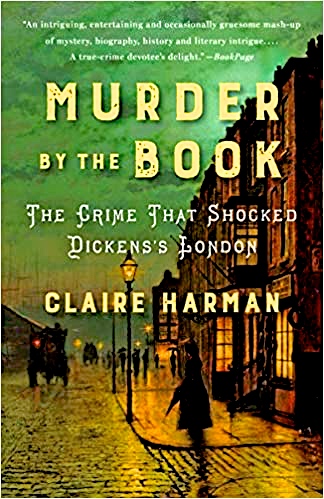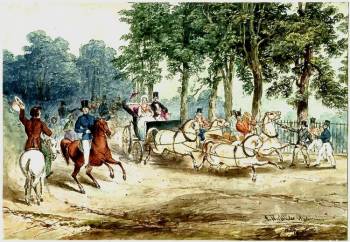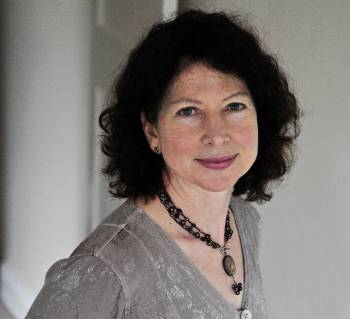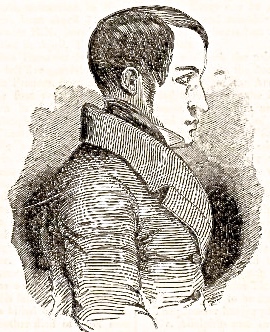“In the summer of 1840, the whole of London, from monarch to maidservants, was gripped by the unfolding drama in Norfolk street, but behind it lay another story, a work of fiction, and an ardent debate about the dangers of glamorizing vice and whether or not serious crime should be portrayed in fiction at all.”
 On May 5, 1840, Lord William Russell, a quiet, elderly member of the aristocracy, was found in the bedroom of his unpretentious London townhouse with his throat slit so severely that his head was almost detached. Other wounds to his chest were equally horrifying. The shock of the murder reverberated throughout the city, especially among the upper classes, who well knew his prominent family and that of his deceased wife. The servant classes, including Lord Russell’s own servants, were all terrified by the potential investigation which might involve them or someone they knew well. A next door neighbor reported that he had heard a brief cry in the middle of the night, and a visitor at a house across the street thought he had seen a naked man through the windows of the Russell house, but there had been no uproar during the time the murder actually took place. The downstairs rooms of the house, in disarray, looked as if they had been burgled, though only a few small things seemed to be missing. When the police came and investigated, they added to the disarray with their own investigations and minor discoveries. With a question as to motivation for the murder, and the murder scene so surprisingly lacking in blood, none of which appeared on the clothing or uniforms of the staff, there were few physical clues. The servants’ quarters and residences were searched with no result.
On May 5, 1840, Lord William Russell, a quiet, elderly member of the aristocracy, was found in the bedroom of his unpretentious London townhouse with his throat slit so severely that his head was almost detached. Other wounds to his chest were equally horrifying. The shock of the murder reverberated throughout the city, especially among the upper classes, who well knew his prominent family and that of his deceased wife. The servant classes, including Lord Russell’s own servants, were all terrified by the potential investigation which might involve them or someone they knew well. A next door neighbor reported that he had heard a brief cry in the middle of the night, and a visitor at a house across the street thought he had seen a naked man through the windows of the Russell house, but there had been no uproar during the time the murder actually took place. The downstairs rooms of the house, in disarray, looked as if they had been burgled, though only a few small things seemed to be missing. When the police came and investigated, they added to the disarray with their own investigations and minor discoveries. With a question as to motivation for the murder, and the murder scene so surprisingly lacking in blood, none of which appeared on the clothing or uniforms of the staff, there were few physical clues. The servants’ quarters and residences were searched with no result.
The social and political situation in England in 1839 – 1840, which involved serious attention being focused on the poor and the non-aristocratic working class, quickly becomes an issue for author Claire Harman, who sees and investigates this murder and its aftereffects as a possible symptom of social change during this period. London was “teeming with immigrants, the unemployed, and a burgeoning working class who were more literate and organized than ever before.” The winter of 1939 had been one of “mass rallies by Chartists demanding universal suffrage,” and in some places had turned into bloody riots. Over two hundred Chartists had been convicted of high treason for their actions and were transported out of the country. Several fiction writers of the period came under fire for “writing fictions that glamorized vice and made heroes of criminals.” Popular books now were seen by some as “pandering to the lowest…full of violent excitements and vulgarity that could all too easily lead susceptible readers astray,” and a whole genre of “Newgate books,” for the masses, evolved.
One such book, written by William Harrison Ainsworth, “the golden boy of his generation,” was Jack Sheppard, which became, for some social critics, a cause célèbre, the story of a real-life petty thief and escape artist who became increasingly violent as he grew older. In a time in which copyrights did not exist, the story about this robber who escapes punishment for his crimes for years could be used and made into a play by anyone at all. Jack Sheppard, was, in fact, turned into six different dramas by six different authors, with all the dramas playing simultaneously in London to huge crowds at the time of the Russell murder. Ainsworth did not make a cent from their success. A book about Sir Samuel Romilly, who had also died from having his throat slit, was found at the Russell crime scene and looked suspicious, since the servants claimed that Sir William never read in bed. Quieter writers, like Charles Dickens, had published Oliver Twist as a serial in 1937 – 39, detailing the life of an impoverished boy who generated much sympathy, and at the time of Lord Russell’s murder, Dicken’s Barnaby Rudge was gaining readers with its brutal stabbing. William Makepeace Thackeray criticized the Newgate novels for their sentimental and sensational content – and also criticized Dickens on the same grounds. In 1839 – 40, Thackeray wrote Catherine under an assumed name, describing the life of a female murderer whom he had intended to make repulsive and whose crimes he planned to use as moral lessons. Then he discovered, to his amazement, that he had unwittingly made her far more sympathetic than he had intended.

1840 Watercolor of Oxford’s assassination attempt. To see enlargement, click on photo, and when the small copy opens on Wikipedia, click on it again to enlarge. Fascinating accuracy.
In the meantime, Norfolk St., the site of the Russell murder, became a tourist destination, with hundreds of interested onlookers crowding the sidewalks around the house. Even Prince Albert became interested in the investigation. In a consummate irony, he and Queen Victoria themselves would become the targets of an assassination plot by Edward Oxford, just a month after the Russell murder. Amidst all the Newgate novels and plays going on simultaneously, and with the real life murders and attempted murders of Lord Russell and later the Queen and Prince Albert, interest in London crime was high. News magazines and papers were selling wildly. The Russell investigation continued, and shortly afterward, Lord Russell’s Swiss valet, François Benjamin Courvoisier was arrested, consigned to await trial at Newgate Prison. Ironically, Edward Oxford was also there, awaiting trial for his attempted murders of the royal family. Both men were convicted, but with different fates.
Claire Harman’s careful research and her eye for telling details, even as she focuses on the broad theme of murder in 1840, and the controversy over whether murder is an appropriate subject of fiction, make this an absorbing study. She draws in the reader with her selection of facts and her elucidation of the goals of literature as seen by famed authors of the day, making them almost as compelling as the gruesome realities of real murder. The many undeveloped details surrounding Lord Russell’s murder, the lack of scientific research, and the omission of any real motive make the reader question the guilt of Courvoisier – or at least question whether he operated alone. He changes his account of the murder several times and even becomes involved in the literary controversy of whether a novel can kill, claiming that he first got the idea of the killing when he saw the play of Jack Sheppard. His demeanor at the conclusion of his trial is bewildering. Author Claire Harman in her “Postscript” chapter offers many new possibilities regarding the murderer and much to think about regarding censorship and freedom of the press.
ALSO by Claire Harman: Jane’s Fame: How Jane Austen Conquered the World
PHOTOS: The author photo by Caroline Forbes appears on https://www.startribune.com
The picture of William Harrison Ainsworth is from https://www.britannica.com
The 1840 watercolor of the attempted assassination of Queen Victoria and Prince Albert by Edward Oxford may be found on https://en.wikipedia.org
The print of Francis Benjamin Courvoisier appears on http://www.executedtoday.com/tag/francois-benjamin-courvoisier/



